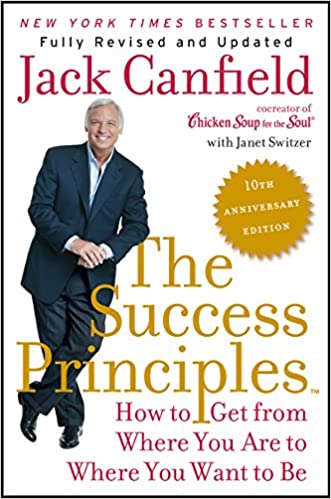The Success Principles - Book Summary and Golden Lines
Having BIG DREAMS, and then doing something about them, is much better than doing nothing at all.

As an Amazon Associate, I earn from qualifying purchases. All affiliate links are marked with an asterisk (*). Thank You! Read more here.

The Book in Three Sentences
- Successful people incorporate similar habits and strategies.
- When you build and practice the same strategies and habits as successful people you put yourself on a pathway to success.
- Having goals and BIG DREAMS, and then doing something about them, is much better than doing nothing at all.
Golden Lines (description and free resource) - These are some of my favorite lines from the book along with my reaction.
First off, there are sixty-seven Success Principles* described in this book. I’ve read through it a few times, and each time I end up highlighting the new information. I’ll list the principles at the end of this post. After the initial reading, it’s probably best to revisit just one principle and focus on it, before moving on to the next one. This book has been updated a few times. I’ll include links to the newest version. Here are some of the Golden Lines.
If you want to be successful, you have to take 100% responsibility for everything that you experience in your life.
- The premise is that if you can’t own your troubles and challenges and your part in creating them, then you also rob yourself of the power to create the successes. This type of thinking only allows for reaction and action with an emphasis on always moving forward.
Ninety-nine percent of all failures come from people who have a habit of making excuses. - GEORGE WASHINGTON CARVER Chemist who discovered over 325 uses for the peanut
- After reading this section of the book I am much more aware of when I’m starting to make an excuse. I now realize that this just isn’t productive. It doesn’t move me any closer to my goals.
Without purpose as the compass to guide you, your goals and action plans may not ultimately fulfill you. You don’t want to get to the top of the ladder only to find out you had it leaning up against the wrong wall.
- It pays off to hit the pause button and spend time deciding where you truly want to end up. Imagine putting forth a bunch of effort only to find yourself somewhere you never wanted to be in the first place.
To create a balanced and successful life, your vision needs to include the following seven areas: work and career, finances, recreation and free time, health and fitness, relationships, personal goals, and contribution to the larger community.
- I used this section of the book to help me set up my goal-setting procedure which is still a work in progress. I’ve never taken much time to write my goals down let alone include goals for each of these seven areas. I'm now trying to build in the habit of reviewing my progress at least once per month.
One of the best ways to get clarity and specificity on your goals is to write them out in detail—as if you were writing specifications for a work order.
- This is the section where your goals become S.M.A.R.T.
The technique you use to do this is called affirmations. An affirmation is a statement that describes a goal in its already completed state, such as “I am enjoying watching the sunset from the lanai of my beautiful beachfront condo on the Ka’anapali coast of Maui” or “I am celebrating feeling light and alive at my perfect body weight of one thirty-five.”
- The idea of affirmations has always seemed a little “hokey” to me. Some of the research cited in this section of the book does have me curious. I have created a few affirmations that I’m testing out. Repeating them still doesn’t feel entirely comfortable but I'm willing to, as Ted Lasso advises, "Be Curious, Non-Judgemental."
By recalling and writing down your successes each day, you log them into your long-term memory, which enhances your self-esteem and builds your self-confidence. And later, if you need a boost of self-confidence, you can reread what you have written.
- I’ve started small with this suggestion and will continue to build my system for capturing my success. I’ve been recording what I call #TeacherWins and #Wins in my DayOne Journal. I’ve been pretty consistent. This practice has me on the lookout for success and positivity. We have a hard time letting go of the things that go wrong which robs us of time we can spend focusing on what's going well.
Most people are afraid to ask for corrective feedback because they are afraid of what they are going to hear. There is nothing to be afraid of. The truth is the truth. You are better off knowing the truth than not knowing the truth.
- As a teacher, I survey my students about three times a year to see how things are going. I receive both positive and negative feedback. In the beginning, it feels uncomfortable, but I’ve been able to improve my classroom instruction by using the information gathered in these surveys.
- I’ve recently started a newsletter - T.G.I.F., that I help to consistently grow and improve. Asking for feedback in this area hasn’t been as easy. I have received helpful feedback. At the end of each newsletter, I ask for comments and feedback. As the newsletter grows I’m hoping this feedback will an important aspect of the process and this it will feel more comfortable each time I ask for it. You can subscribe to the T.G.I.F. newsletter here 😉.
Here are the 67 Success Principles outlined in the book.
I. THE FUNDAMENTALS OF SUCCESS
Take 100% Responsibility for Your Life
Be Clear About Why You’re Here
Decide What You Want
Believe It’s Possible
Believe in Yourself
Use the Law of Attraction
Unleash the Power of Goal-Setting
Chunk It Down
Success Leaves Clues
Release the Brakes
See What You Want, Get What You See
Act As If
Take Action
Just Lean Into It
Experience Your Fear and Take Action Anyway
Be Willing to Pay the Price
Ask! Ask! Ask!
Reject Rejection
Use Feedback to Your Advantage
Commit to Constant and Never-Ending Improvement
Keep Score for Success
Practice Persistence
Practice the Rule of 5
Exceed Expectations
II. TRANSFORM YOURSELF FOR SUCCESS
Drop Out of the “Ain’t It Awful” Club . . . and Surround Yourself with Successful People
Acknowledge Your Positive Past
Keep Your Eye on the Prize
Clean Up Your Messes and Your Incompletes
Complete the Past to Embrace the Future
Face What Isn’t Working
Embrace Change
Transform Your Inner Critic into an Inner Coach
Transcend Your Limiting Beliefs
Develop Four New Success Habits a Year
99% Is a Bitch; 100% Is a Breeze
Learn More to Earn More
Stay Motivated with the Masters
Fuel Your Success with Passion and Enthusiasm
III. BUILD YOUR SUCCESS TEAM
Stay Focused on Your Core Genius
Redefine Time
Build a Powerful Support Team and Delegate to Them
Just Say No!
Become a Leader Worth Following
Create a Network of Mentors and Others Who Will Up-Level You
Hire a Personal Coach
Mastermind Your Way to Success
Inquire Within
IV. CREATE SUCCESSFUL RELATIONSHIPS
Be Hear Now
Have a Heart Talk
Tell the Truth Faster
Speak with Impeccability
When in Doubt, Check It Out
Practice Uncommon Appreciation
Keep Your Agreements
Be a Class Act
V. SUCCESS AND MONEY
Develop a Positive Money Consciousness
You Get What You Focus On
Pay Yourself First
Master the Spending Game
To Spend More, First Make More
Give More to Get More
Find a Way to Serve
VI. SUCCESS IN THE DIGITAL AGE
Master the Technology You Need
Brand Yourself with an Online Persona
Use Social Media in a Way That Enhances Your Reputation
Use the Exponential Power of Crowdfunding
Connect with People Who Can Expand Your Vision
I recommend this book. If you are a teacher you’ll find useful information to apply both in and out of the classroom. Most anyone will find something valuable that they can apply to their life. Remember, this book is meant to be revisited. It would be impossible to apply all of the Success Principles at once, and you might not want to apply all of them to your life. Pick a few to try out and see what happens.
As a teacher, I’m always asking students what their BIG DREAMS are. I think goals stretch us to become better. They also can provide relevancy for students. The same is true for us adults. There are many things that can get in the way of achieving goals. The Success Principles may help you overcome these obstacles.
You'll find a link to the Success Principles below. If you use it to purchase the book I'll earn a small commission which helps to support this site which is greatly appreciated 🙏.

The Success Principles(TM) - 10th Anniversary Edition: How to Get from Where You Are to Where You Want to Be
Learn strategies you can implement today that will put you on the pathway to success.
Thank you for reading and good luck on your Journey. Here is the Book Notes archive if you'd like to check out some of the summaries and Golden Lines of other books I've enjoyed.



